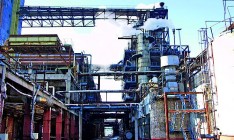Business
BankruptcyDmytro Firtash will get Sumykhimprom for its debts

The fate of Sumykhimprom will be decided on December 15. As it turned out, the Commercial Court in the Sumy oblast will consider the possibility of extension of the term of recovery of the enterprise at the insistence of the creditors’ committee, according to Sumykhimprom’s property manager, arbitration manager and senior partner at the Ilyashev & Partners Law Firm Roman Marchenko.
He says if the court does not agree with the new plan for reorganization of the company proposed by the creditors’ committee, Sumykhimprom may face liquidation. “We tried to defer this procedure for as long as we could in order that the banks would not be able to sequester property of state enterprise for its debts on loans,” said Marchenko.
Firtash buys debts
If the court decides that the plant is subject to liquidation, there will be nothing left for privatization and the right to use most of the property will be given to the main creditor of the enterprise, a partner of a law firm said requesting anonymity. As is known, the main creditors of Sumykhimprom are the structures owned by Dmytro Firtash – Industrial Investments, Syntez Resurs, Crimea Titan, OSTCHEM International and Nadra Bank. They constitute the creditors’ committee of Sumykhimprom. By the way, on November 25 Firtash’ Syntez Resurs appealed to the Commercial Court of the Sumy Oblast stating that the company will inherit the rights of one of Sumykhimprom’s creditors – AKB Industrialbank. For this reason, a request was made to add to the creditors’ list the company’s debt to the bank (and now to Syntez Resurs) in the amount of UAH 234.9 mn.
This means that Sumykhimprom’s debt to Industrialbank was assigned to Syntez Resurs. Thus, Firtash’ companies accumulate the company’s debt, obviously in preparation for the possible liquidation of the enterprise.
Blast from the past
On December 4 the meeting of creditors approved a new reorganization plan for Sumykhimprom. It is not much different from the previous one, which was rejected by the representative of the state – the owner of Sumykhimprom – the State Property Fund. The new plan and the previous one, according to Marchenko, suggests that the plant will be able to recover its losses in full only 17 years from now. During this period the company should eliminate the registered debt of UAH 1.4 bn. In addition, it is expected that the chemical plant will achieve its production targets and again become profitable. Simultaneously, the plant will operation all this time and pay salaries to its employees, thereby preserving its profile – specifically, production of complex fertilizers and titanium dioxide. Noteworthy, in January–September 2014 the company reduced its net losses by 2.3 times to UAH 59.08 mn, and the net profit of Sumykhimprom increased by 18.8% to UAH 1.408 bn.
Representatives of the State Property Fund (SPF) say they have not seen this version of the recovery plan yet, which is why they refused to make comments. From experience, we can assume that the SPF will again refuse to endorse the plan for recovery of Sumykhimprom as it did not accept the term of rehabilitation the last time. Thus, the courts will decide whether Firtash’ management will be overseeing the plant for another 17 years as its main creditor or Firtash’ structures will get the enterprise for its debts.
Answering why the lenders agreed on 17 years of rehabilitation, Marchenko said that the plant would need this time to climb out of the debt hole on its own. “Had we been able to find an investor that would have shouldered the debts of the business and took up its modernization, which, according to our estimates, requires UAH 5 bn, perhaps the process of rehabilitation would not be as long,” said Marchenko.
SPF plays along with Firtash
Thus, the fate of Sumykhimprom is prejudicial: either the company formally remains for another 17 years under state ownership, though under control of Firtash, if the court agrees with the reorganization plan or it de facto becomes the property of the main lender in the process of liquidation. By not supporting the rehabilitation plan, the SPF is encouraging Sumykhimprom to choose the second option.
However, legal experts believe that protracting rehabilitation of Sumykhimprom for 17 years is quite realistic. “If the reorganization plan is sound and its authors manage to convince the court that it really gives the company a chance to survive and prosper in the future, the judges will not be confused by such a long period of recovery,” says a partner at the Dominion Law Group.






 of the agreement of syndication with Financial Times Limited are strictly prohibited. Use of materials which refers to France-Presse, Reuters, Interfax-Ukraine, Ukrainian News, UNIAN agencies is strictly prohibited. Materials marked
of the agreement of syndication with Financial Times Limited are strictly prohibited. Use of materials which refers to France-Presse, Reuters, Interfax-Ukraine, Ukrainian News, UNIAN agencies is strictly prohibited. Materials marked  are published as advertisements.
are published as advertisements.